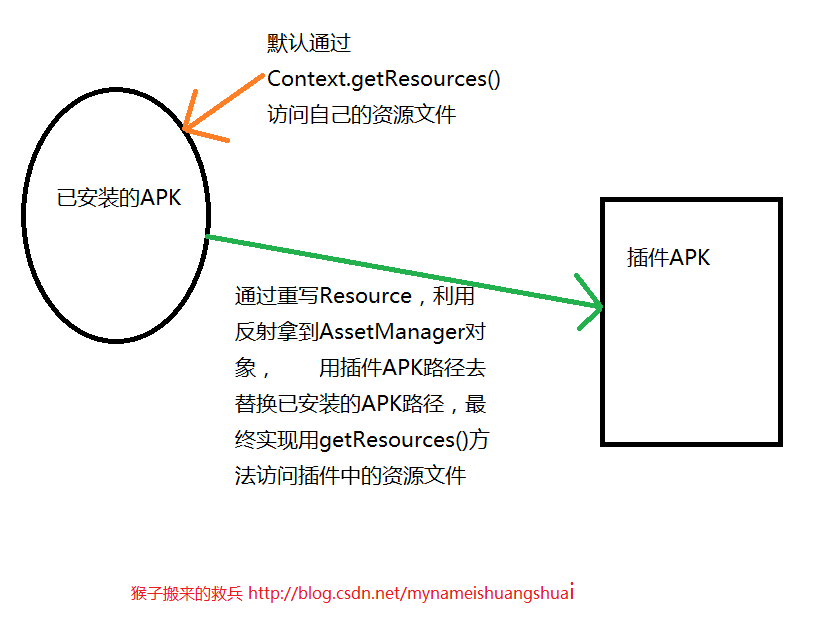詳解Android外掛化開發-資源訪問
動態載入技術(也叫外掛化技術),當專案越來越龐大的時候,我們通過外掛化開發不僅可以減輕應用的記憶體和CPU佔用,還可以實現熱插拔,即在不釋出新版本的情況下更新某些模組。
通常我們把安卓資原始檔製作成外掛的形式,無外乎有一下幾種:
zip、jar、dex、APK(未安裝APK、安裝APK)
對於使用者來講未安裝的APK才是使用者所需要的,不安裝、不重啟,無聲無息的載入資原始檔,這正是我們開發者追求的結果。
但是,開發中宿主程式調起未安裝的外掛apk,一個很大的問題就是資源如何訪問,這些資原始檔的ID都對映在gen資料夾下的R.java中,而外掛中凡是以R開頭的資源都不能訪問。究其原因是因為宿主程式中並沒有外掛的資源,所以通過R來載入外掛的資源是行不通的,程式會丟擲異常:無法找到某某id所對應的資源。
那麼開發中該怎麼辦呢,今天我們來一起探討一下外掛化開發中資原始檔訪問的解決方案。
想必大家在開發中都寫過類似程式碼,例如,在主程式訪問字串檔案
this.getResources().getString(R.string.app_name);這裡的this,其實就是Context,上下文物件。通常我們的的APK安裝路徑為:
/data/apk/packagename~1/base.apk
APK啟動,Context通過類載入器載入完畢後,會去APK中載入資原始檔。想必大家都知道,Activity的工作主要是通過ContextImpl來完成的, Activity中有一個叫mBase的成員變數,它的型別就是ContextImpl。注意到Context中有如下兩個抽象方法,看起來是和資源有關的,實際上Context就是通過它們來獲取資源的。這兩個抽象方法的真正實現在ContextImpl中,也就是說,只要實現這兩個方法,就可以解決資源問題了。
/** Return an AssetManager instance for your application's package. */
public abstract AssetManager getAssets();
/** Return a Resources instance for your application's package. */
public abstract Resources getResources();我們若是想使用這兩個方法,需要例項化Context物件,通常我們可以根據APK中的包名完成Context物件的建立:
Context pluginContext = this 但是這樣做有個前提,必須要求初始化時載入的是自己APK,如果我們載入的是未安裝的外掛APK,這麼做肯定就不可取了。為啥呢,看原始碼:
Resources resources = packageInfo.getResources(mainThread);
if (resources != null) {
if (activityToken != null
|| displayId != Display.DEFAULT_DISPLAY
|| overrideConfiguration != null
|| (compatInfo != null && compatInfo.applicationScale
!= resources.getCompatibilityInfo().applicationScale)) {
resources = mResourcesManager.getTopLevelResources(packageInfo.getResDir(),
packageInfo.getSplitResDirs(), packageInfo.getOverlayDirs(),
packageInfo.getApplicationInfo().sharedLibraryFiles, displayId,
overrideConfiguration, compatInfo, activityToken);
}
}
mResources = resources;Resources在這裡被賦值,我們再去程式碼中第一行的packageInfo,它來自LoadedApk類,其中的getResources方法如下:
public Resources getResources(ActivityThread mainThread) {
if (mResources == null) {
mResources = mainThread.getTopLevelResources(mResDir, mSplitResDirs, mOverlayDirs,
mApplicationInfo.sharedLibraryFiles, Display.DEFAULT_DISPLAY, null, this);
}
return mResources;
}該方法採用單例模式,注意其中的getTopLevelResources()方法中的第一個引數mResDir,我們繼續找其源頭,在ActivityThread類中,發現了:
/**
* Creates the top level resources for the given package.
*/
Resources getTopLevelResources(String resDir, String[] splitResDirs, String[] overlayDirs,
String[] libDirs, int displayId, Configuration overrideConfiguration,
LoadedApk pkgInfo) {
return mResourcesManager.getTopLevelResources(resDir, splitResDirs, overlayDirs, libDirs,
displayId, overrideConfiguration, pkgInfo.getCompatibilityInfo(), null);
}重點看裡面的resDir引數,我們再往上找原始碼,最終找到ResourcesManager類,找到getTopLevelResources()方法:
/**
* Creates the top level Resources for applications with the given compatibility info.
*
* @param resDir the resource directory.
* @param overlayDirs the resource overlay directories.
* @param libDirs the shared library resource dirs this app references.
* @param compatInfo the compability info. Must not be null.
* @param token the application token for determining stack bounds.
*/
public Resources getTopLevelResources(String resDir, String[] splitResDirs,
String[] overlayDirs, String[] libDirs, int displayId,
Configuration overrideConfiguration, CompatibilityInfo compatInfo, IBinder token) {
final float scale = compatInfo.applicationScale;
ResourcesKey key = new ResourcesKey(resDir, displayId, overrideConfiguration, scale, token);
Resources r;
synchronized (this) {
// Resources is app scale dependent.
if (false) {
Slog.w(TAG, "getTopLevelResources: " + resDir + " / " + scale);
}
WeakReference<Resources> wr = mActiveResources.get(key);
r = wr != null ? wr.get() : null;
//if (r != null) Slog.i(TAG, "isUpToDate " + resDir + ": " + r.getAssets().isUpToDate());
if (r != null && r.getAssets().isUpToDate()) {
if (false) {
Slog.w(TAG, "Returning cached resources " + r + " " + resDir
+ ": appScale=" + r.getCompatibilityInfo().applicationScale);
}
return r;
}
}
//if (r != null) {
// Slog.w(TAG, "Throwing away out-of-date resources!!!! "
// + r + " " + resDir);
//}
AssetManager assets = new AssetManager();
// resDir can be null if the 'android' package is creating a new Resources object.
// This is fine, since each AssetManager automatically loads the 'android' package
// already.
if (resDir != null) {
if (assets.addAssetPath(resDir) == 0) {
return null;
}
}
if (splitResDirs != null) {
for (String splitResDir : splitResDirs) {
if (assets.addAssetPath(splitResDir) == 0) {
return null;
}
}
}
if (overlayDirs != null) {
for (String idmapPath : overlayDirs) {
assets.addOverlayPath(idmapPath);
}
}
if (libDirs != null) {
for (String libDir : libDirs) {
if (assets.addAssetPath(libDir) == 0) {
Slog.w(TAG, "Asset path '" + libDir +
"' does not exist or contains no resources.");
}
}
}
//Slog.i(TAG, "Resource: key=" + key + ", display metrics=" + metrics);
DisplayMetrics dm = getDisplayMetricsLocked(displayId);
Configuration config;
boolean isDefaultDisplay = (displayId == Display.DEFAULT_DISPLAY);
final boolean hasOverrideConfig = key.hasOverrideConfiguration();
if (!isDefaultDisplay || hasOverrideConfig) {
config = new Configuration(getConfiguration());
if (!isDefaultDisplay) {
applyNonDefaultDisplayMetricsToConfigurationLocked(dm, config);
}
if (hasOverrideConfig) {
config.updateFrom(key.mOverrideConfiguration);
}
} else {
config = getConfiguration();
}
r = new Resources(assets, dm, config, compatInfo, token);
if (false) {
Slog.i(TAG, "Created app resources " + resDir + " " + r + ": "
+ r.getConfiguration() + " appScale="
+ r.getCompatibilityInfo().applicationScale);
}
synchronized (this) {
WeakReference<Resources> wr = mActiveResources.get(key);
Resources existing = wr != null ? wr.get() : null;
if (existing != null && existing.getAssets().isUpToDate()) {
// Someone else already created the resources while we were
// unlocked; go ahead and use theirs.
r.getAssets().close();
return existing;
}
// XXX need to remove entries when weak references go away
mActiveResources.put(key, new WeakReference<Resources>(r));
return r;
}
}該方法的註釋中,明確指出@param resDir the resource directory,載入本地資源目錄,載入自己的APK。
通過以上的分析,我們知道getResources()方法通過AssetManager載入自己的APK,那麼我們要想載入未安裝的外掛APK,唯有自定義實現一個Resources類,專門用來載入未安裝的APK。但是我試過了,直接重寫不行,為啥,因為Android並沒有提供Resource構造方法中的AssetManager的構造方法,我們看下原始碼:
/**
* Create a new Resources object on top of an existing set of assets in an
* AssetManager.
*
* @param assets Previously created AssetManager.
* @param metrics Current display metrics to consider when
* selecting/computing resource values.
* @param config Desired device configuration to consider when
* selecting/computing resource values (optional).
*/
public Resources(AssetManager assets, DisplayMetrics metrics, Configuration config) {
this(assets, metrics, config, CompatibilityInfo.DEFAULT_COMPATIBILITY_INFO);
}接著再看一下Resource構造方法中的AssetManager引數原始碼
/**
* Create a new AssetManager containing only the basic system assets.
* Applications will not generally use this method, instead retrieving the
* appropriate asset manager with {@link Resources#getAssets}. Not for
* use by applications.
* {@hide}
*/
public AssetManager() {
synchronized (this) {
if (DEBUG_REFS) {
mNumRefs = 0;
incRefsLocked(this.hashCode());
}
init(false);
if (localLOGV) Log.v(TAG, "New asset manager: " + this);
ensureSystemAssets();
}
}注意註釋中的{@hide},隱藏起來了,Android系統不讓我們使用。既然不讓我們直接使用,那我們可以採用反射的方式來拿到AssetManager。接下來我把自定義的實現類貼出來,給大家示例:
/**
*
* @ClassName: MyPluginResources
* @Description: 自定義外掛資原始檔獲取工具類
* @author 猴子搬來的救兵http://blog.csdn.net/mynameishuangshuai
* @version
*/
public class MyPluginResources extends Resources{
public MyPluginResources(AssetManager assets, DisplayMetrics metrics, Configuration config) {
super(assets, metrics, config);
}
/**
* 自定義返回外掛的資原始檔的Resource方法
* @param resources
* @param assets
* @return
*/
public static MyPluginResources getPluginResources(Resources resources,AssetManager assets){
MyPluginResources pluginResources = new MyPluginResources(assets, resources.getDisplayMetrics(), resources.getConfiguration());
return pluginResources;
}
//自己定義載入外掛APK的AssetsManager
public static AssetManager getPluginAssetsManager(File apkFile,Resources resources) throws ClassNotFoundException{
// 由於系統沒有提供AssetManager的例項化方法,因此我們使用反射
Class<?> forName = Class.forName("android.content.res.AssetManager");
Method[] declaredMethods = forName.getDeclaredMethods();
for(Method method :declaredMethods){
if(method.getName().equals("addAssetPath")){
try {
AssetManager assetManager = AssetManager.class.newInstance();
// 呼叫addAssetPath方法,引數為我們外掛APK的路徑
method.invoke(assetManager, apkFile.getAbsolutePath());
return assetManager;
} catch (Exception e) {
e.printStackTrace();
}
}
}
return null;
}
}這樣,我們在專案中就可以使用我們自定義的AssetManager來獲取未安裝外掛APK中的資原始檔
AssetManager assetManager = PluginResources.getPluginAssetsManager(apkFile,
this.getResources());參考:《Android開發藝術探索》

